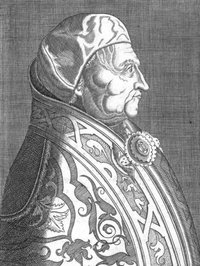 The man chosen to succeed Calixtus III was the humanist, historian,
statesman, and reformed rake, Aeneas Sylvius Piccolomini. Aeneas Sylvius
was born at Corsignano near Siena of poor but noble parents. He studied at
the University of Siena and later sat at the feet of Filelfo in Florence.
Aeneas Sylvius combined hard study with loose living. Though he took canon
law and entered the ecclesiastical service, he had too much respect for
holy orders to become a priest living as he was. He served various princes
of the Church, including Capranica and Albergati. On a mission to Scotland
when his ship was threatened by a storm, Aeneas Sylvius vowed to walk
barefoot to the nearest shrine of Our Lady if a landfall was safely made.
The nearest shrine was ten miles away from the landfall, but Aeneas Sylvius
resolutely trudged barefoot through bleak Scottish snow to pay his debt. It
cost him dearly, for he contracted gout, a disease which tormented him the
rest of his life.
The man chosen to succeed Calixtus III was the humanist, historian,
statesman, and reformed rake, Aeneas Sylvius Piccolomini. Aeneas Sylvius
was born at Corsignano near Siena of poor but noble parents. He studied at
the University of Siena and later sat at the feet of Filelfo in Florence.
Aeneas Sylvius combined hard study with loose living. Though he took canon
law and entered the ecclesiastical service, he had too much respect for
holy orders to become a priest living as he was. He served various princes
of the Church, including Capranica and Albergati. On a mission to Scotland
when his ship was threatened by a storm, Aeneas Sylvius vowed to walk
barefoot to the nearest shrine of Our Lady if a landfall was safely made.
The nearest shrine was ten miles away from the landfall, but Aeneas Sylvius
resolutely trudged barefoot through bleak Scottish snow to pay his debt. It
cost him dearly, for he contracted gout, a disease which tormented him the
rest of his life.
His conversion, however, did not yet take place. He joined the schismatic
Council of Basel and formed one of a rebellious and loose-living circle
there. He wrote tracts against the Pope, and filthy prose and poetry which
would cause Pius II much bitter regret. Having a keen sense of the wind's
direction, Aeneas abandoned the moribund Basel council for the service,
first of the Emperor Frederick III, then of the Pope. He served the papacy
well, taking a large part in the negotiations which led to the Concordat of
Vienna. Calixtus III made him cardinal in 1456, and in 1458 after a
somewhat difficult conclave. Aeneas Sylvius emerged as pope. He chose the
name Pius II.
Pius had already turned over a new leaf when he had become a priest. Now he
strove to live up to his chosen name. He publicly retracted his youthful
errors and bade the Christian world to reject Aeneas but accept Pius. As
pope, he led a simple life more like that of a monk than of a Renaissance
prince. He loved nature, and whenever possible he worked outdoors. He was
accustomed to give audiences sitting under the chestnut trees or beside
some splashing fountain.
If the humanists expected a return of the golden age of Nicholas V, they
were disappointed. Pius did not altogether neglect the arts, but his main
concern was to carry on the crusading policy of Calixtus III. The necessity
of a crusade was impressed upon him by the piteous complaints of princes
driven from Greece and the Eastern islands by Ottoman might. Pius called a
congress of the powers to meet at Mantua in 1459, but the congress did
little else than prove the Pope's zeal. Power politics, and narrow power
politics at that, prevailed among the monarchs of Renaissance Europe.
Pius enjoyed one great triumph when he succeeded in getting Louis XI of
France to abrogate the Pragmatic Sanction of Bourges. Even this, however,
was spoiled by future encroachments of the spider king.
Although he saw the need for a thoroughgoing reform, Pius undertook only
partial reforms. He concentrated on the crusade. He even wrote a letter to
Sultan Mohammed II, urging him to become a Christian. No answer. At last,
as if to shame the sluggard kings, Pius, old and sick, dragged himself to
Ancona, where he had assembled a small crusading army. Fever struck him
down, and on August 14, 1464, he died on the shores of the Adriatic,
looking towards the East he had so much desired to help.
Excerpted from "Popes
Through the Ages" by Joseph Brusher, S.J.

